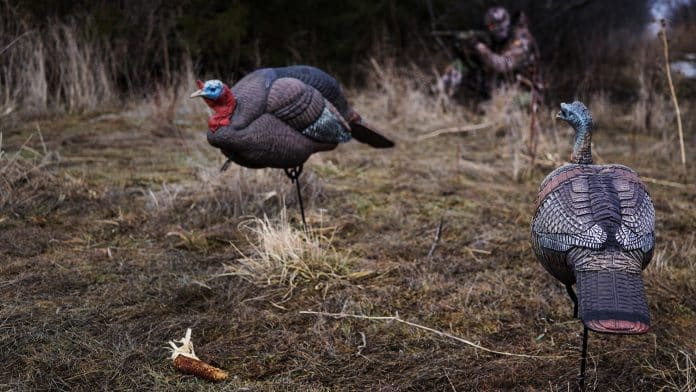I hunt a lot during the early part of the season with decoys. Turkey decoys come in all shapes and sizes, and just about any of them can be an asset to a turkey hunter, especially when you’re calling an older tom who needs to see another turkey to ease his suspicions. Not everybody uses them; even I don’t use them on every hunt. But, they are a good tool to employ to bring in a longbeard. Here are a couple of thoughts on using decoys I hope will help you out.
The single best decoy anyone can own is a submissive, half- or quarter-strut jake. A jake is an immature gobbler, just a kid, and these dekes are effective all spring, so long as you pair them with the right birds. A laydown hen decoy is great to go alongside a jake deke, especially for the first couple of weeks of the season. A laying down hen mimics a hen lowering herself into a breeding position. Any longbeard which sees a jake in a position with a receptive hen will come in to run him off and claim the hen for himself. Just make sure the laydown hen is visible to approaching birds and not obscured by grass or brush.
A multi-bird setup is good, but can be even better if you trail your tiny flock of hens with a jake; especially in the first half of the season. Position them facing your setup, all in the same direction, with the jake in last place. The ruse should look like a small flock walking away from the gobbler, with the only male in the group about to get lucky. Mister Gobbler isn’t very likely to pass up multiple hens with only a punk jake standing in his way.
By late March, the fever of the season has died down, and there are a lot of loners on the landscape. The big gobblers are still workable, but they don’t want to fight anymore, and they really only want a sure thing. Hunting later in the year, you tend to see lots of single or paired-up hens and mostly lone gobblers or small groups of jakes. This is likely due to the availability of food (insects and fresh growth), as well as the amount of nesting going on. Plus, the birds no longer need to be concentrated, and they spread out across their entire home range.
Them older toms know this, so when they encounter a solo decoy, or maybe a feeder and an upright hen, it jives with what’s going on with the flock at that moment. In their eyes, they’ve found a willing companion with no competition. Give them what they expect to see, and it’ll go a long way towards letting you tote home a longbeard you can grin about.
As always, I’d love to hear about your own outdoor adventures and maybe see a photo or two of your successes at [email protected]. God bless, and good hunting!

